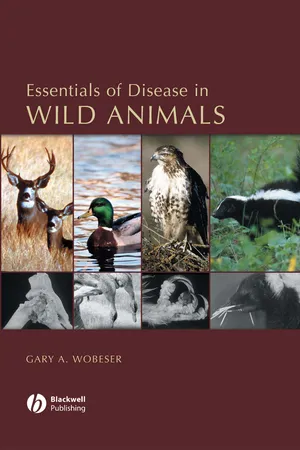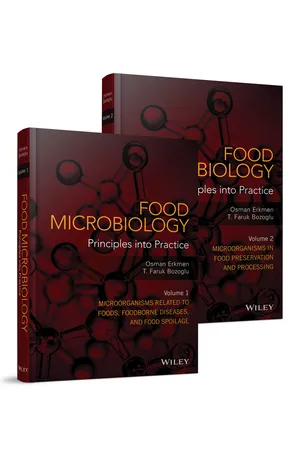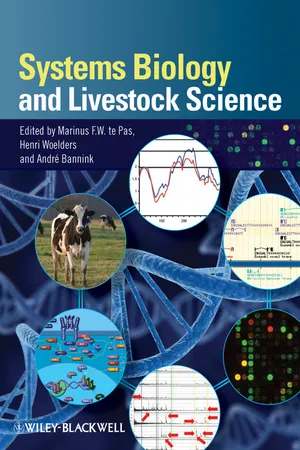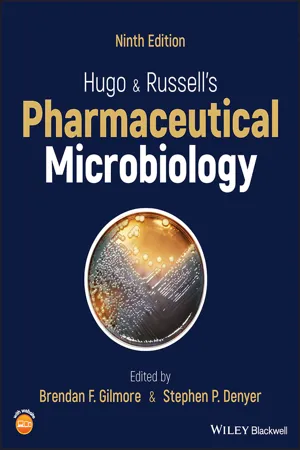Biological Sciences
Pathogenicity
Pathogenicity refers to the ability of a microorganism, such as a virus, bacterium, fungus, or parasite, to cause disease in a host organism. It involves the mechanisms by which the pathogen enters the host, evades the host's immune system, and causes damage to the host's cells and tissues. Understanding pathogenicity is crucial for developing strategies to prevent and treat infectious diseases.
Written by Perlego with AI-assistance
Related key terms
6 Key excerpts on "Pathogenicity"
- eBook - ePub
- Gary A. Wobeser(Author)
- 2013(Publication Date)
- Wiley-Blackwell(Publisher)
5
Damage, Pathogenicity, and Virulence
The fundamental feature of disease, regardless of cause, is that there is dysfunction that causes harm or cost to the affected animal. The harm may range from effects that are so mild that they are undetectable with most measures that we use commonly (but not necessarily insignificant biologically) to conditions that are acutely lethal to the individual.A term is needed that expresses the relative propensity of an agent to injure the animal so that different diseases can be discussed and compared. Two candidate words are in common usage: virulence and Pathogenicity , both of which have been used primarily to describe disease caused by infectious agents. Virulence is derived from Latin virulentus (poisonous) and pathogenesis is derived from Greek pathos (suffering) + genesis (generation or creation), hence, creation of suffering. Virulence is defined in a medical dictionary as “the degree of Pathogenicity of a microorganism as indicated by case fatality rates and/or its ability to invade the tissues of the host” (Dorland 2000). Pathogenicity is defined as “the ability of a microorganism to produce disease.” The word “virulence” also has been used to describe “the ability to cause disease” and virulent as “actively poisonous, intensely noxious, venomous,” suggesting that on an etymological basis, virulence should be equally applicable to non-infectious and infectious causes of disease.Virulence will be used here as a measure of the ability of an agent to cause harm. The degree of injury will not be limited to increased mortality of affected animals. This definition of virulence is similar to “the harm done to hosts following infection” used by Read et al. (1999). Hochberg and van Baalen (2000) described two types of virulence that occur in infectious diseases. Type 1 is related to the compatibility of a parasite for a specific host and the evasion or manipulation of the host’s defenses during the sequential stages of infection, development, and transmission from the host. Type 2 deals with the effects of infection on host fitness in terms of increased probability of mortality, reduced levels of reproduction, alterations in host life history, and homeostasis. Only type 2 virulence will be dealt with here. In human and veterinary medicine, virulence usually is considered at the level of the individual person or animal. For wild animals, effects on the individual animal are important primarily for their consequences for host life span and fecundity and for how these influence host fitness and population density, so we must consider virulence in that context. Schall (2002) considered that, from the host animal’s perspective, virulence is any consequence of infection that reduces the host’s lifetime reproductive success. - eBook - ePub
Food Microbiology
Principles into Practice
- Osman Erkmen, T. Faruk Bozoglu(Authors)
- 2016(Publication Date)
- Wiley(Publisher)
Chapter 7 Bacterial Pathogenicity and Microbial Toxins7.1 Introduction
A pathogen is a microorganism capable of causing diseases in human beings and animals. Pathogenicity is the ability to cause disease in a host organism. Microorganisms express their Pathogenicity by means of their virulence characteristics. Determinants of virulence of a pathogen are genetic, biochemical, and structural characteristics that enable it to produce disease in a host. The relationship between a host and a pathogen depends on the virulence ability of the pathogen and the relative degree of resistance or susceptibility of the host. Virulence provides a quantitative measure of the Pathogenicity or the ability of causing disease. Virulence factors affect the Pathogenicity of microorganisms. Some of the virulence factors are adherence, which is the ability of pathogen to colonize on the mucosal membrane by using pili (fimbriae); invasion factors, which are surface components that allow the bacterium to invade host cells; capsules, which are surrounded polysaccharides that protect them from opsonization and phagocytosis; endotoxins, which can cause fever, changes in blood pressure, inflammation, lethal shock, and many other toxic events; and exotoxins, which are proteins and enzymes produced and/or secreted from pathogenic bacteria.Pathogenic bacteria cause invasiveness and toxigenicity. Invasiveness is the ability of pathogen to invade tissues. It enhances colonization (adherence and initial multiplication), increases production of extracellular substances that facilitate invasion, provides ability to bypass, and enables to overcome host defense mechanisms. Invasion involves the ability of the bacterium to grow in the host, either in an extracellular environment or in an intracellular environment. Invasive bacteria injure the host tissue through the production of extracellular enzymes.Toxigenesis is the ability of pathogen to produce toxins. Bacterial pathogens that damage the host through the action of toxins are called noninvasive (toxigenic); they have limited capacity to spread in the host, but bacterial toxins often act distanced from the site of infection. Bacterial toxins are transported across the bacterial membranes through cotranslational and posttranslational mechanisms to reach their targets. Transport systems mostly use active transport, requiring energy. - eBook - ePub
- Marinus te Pas, Henri Woelders, André Bannink(Authors)
- 2011(Publication Date)
- Wiley-Blackwell(Publisher)
In a general sense, the research field of host–pathogen interactions is well developed due to its impact and importance of infectious diseases that threaten human and animal health. The field is closely linked to our growing fundamental understanding of the host's innate and adaptive immune system and to our current understanding of the wide variety of mechanisms that pathogenic microorganisms use to invade, reside, and replicate within hosts. Quantitative and qualitative aspects of host–pathogen interactions determine whether pathogens are able to invade hosts, survive and replicate, spread throughout the body, and transmitted to other hosts. These aspects also determine the pathology and severity of the disease resulting from the interplay between host and pathogen: either elimination or colonization of the microbe without causing clinical signs of disease, or colonization of the microbe causing diseas, ranging from mild to deadly. Both microbial virulence as well as host disease susceptibilities are frequently seen as traits of pathogens and hosts, respectively. However, this is not correct since both depend on dynamic interactions between the two (Casadevall and Pirofski, 2000).Recent studies focusing on host–pathogen interactions increasingly use high-throughput -omics technologies that generate ten to several hundred of thousands of data points. They provide genome-wide global views of the molecular structures and molecular compositions of biological samples. Such studies have shed light on several virulence strategies used by microbes, on a number of defense strategies used by hosts, and on several mechanisms by which the interactions between hosts and pathogens are influenced by external factors, such as nutrition and stress. However, biological functions do not simply manifest themselves from the addition of the properties of system components, but rather arise from the dynamic interactions of these components. In addition, individual studies usually focus on one specific biological level, i.e., genes, cytokines, or macrophage activity, on particular cells or tissues, i.e., dendritic cells (DCs) or spleen, a particular time frame, and either host-response or pathogen inference. However, to understand the genetics and physiology of host–pathogen interactions, it is required to get data information from different time frames and different scales, i.e., genes, molecules, networks, pathways, cells (host as well as pathogens), tissues, organs, organisms. - eBook - ePub
- Rene Krata(Author)
- 2011(Publication Date)
- Barrons Educational Series(Publisher)
20Pathogenicity ofMicroorganisms WHAT YOU WILL LEARNThis chapter takes a look at the various tools and tricks pathogens use in order to colonize the body and get past your defenses. As you study this chapter, you will: • examine how pathogens enter the body; • discover the importance of attachment; • learn how pathogens evade defenses like complement and phagocytosis; • explore how pathogens damage host tissues with toxins.SECTIONS IN THIS CHAPTER• Ability to Invade Tissues• Evasion of Host Defenses• Damage to the HostThe human body has amazing defenses against invasion by microorganisms. Most microbes we encounter are prevented from establishing an infection by our innate immunity (Chapter 18 ). Those that do establish an infection are usually defeated by our adaptive immunity (Chapter 19 ). So why is it that we get sick at all? How do some microbes manage to get around our defenses? Why does their presence in our bodies cause disease?The ability of a microorganism to cause disease is its Pathogenicity . A more familiar term might be virulence , which refers to the degree of Pathogenicity. For example, an organism that very easily causes disease would be considered highly virulent. Microorganisms that are highly virulent have the ability to colonize the host easily and disrupt the host physiology. Any molecules that a microorganism makes and that help them to cause disease are called virulence factors . In other words, virulence factors are like the tool kit of a pathogen. What makes one pathogen different from another is what they have in their tool kit.REMEMBERA virulence factor is any molecule that helps a pathogen cause disease.The ability of a pathogen to cause disease depends on three main issues. First, the pathogen must be able to invade the host. Second, it must be able to evade the host defenses. And finally, it may produce enzymes or toxins that damage host tissues and contribute to the signs and symptoms of disease. The different strategies that pathogens use to invade the human body are truly amazing, and understanding the details of these mechanisms can help us figure out new ways to prevent disease. - eBook - ePub
- Stephen P. Denyer, Norman A. Hodges, Sean P. Gorman, Brendan F. Gilmore(Authors)
- 2011(Publication Date)
- Wiley-Blackwell(Publisher)
Part 2 Pathogens and host responsesPassage contains an image 7 Principles of microbial Pathogenicity and epidemiology David Allison and Andrew McBain University of Manchester, Manchester, UK 1 Introduction 2 The human microbiome 3 Portals of entry 3.1 Skin 3.2 Respiratory tract 3.3 Intestinal tract 3.4 Urinogenital tract 3.5 Conjunctiva 4 Consolidation 4.1 Nutrient acquisition 4.2 Biofilms 4.3 Resistance to host defences 4.3.1 Modulation of the inflammatory response 4.3.2 Avoidance of phagocytosis 4.3.3 Survival following phagocytosis 4.3.4 Killing of phagocytes 5 Manifestation of disease 5.1 Non-invasive pathogens 5.2 Partially invasive pathogens 5.3 Fully invasive pathogens 5.3.1 Active spread 5.3.2 Passive spread 6 Damage to tissues 6.1 Direct damage 6.1.1 Specific effects 6.1.2 Non-specific effects 6.2 Indirect damage 7 Recovery from infection: exit of microorganisms 8 Epidemiology of infectious disease 9 Further reading 1 Introduction
Microorganisms are ubiquitous, and most of them are free-living and derive their nutrition from inert organic and inorganic materials. The association of humans with such microorganisms is generally harmonious, as the majority of those encountered are benign and, indeed, are often vital to commerce, health and a balanced ecosystem. The ability of bacteria and fungi to establish infections of plants, animals and humans varies considerably. Some are rarely, if ever, isolated from infected tissues, while opportunist pathogens (e.g. Pseudomonas aeruginosa or Staphylococcus epidermidis ) can establish themselves only in compromised individuals. Only a few species of bac-teria may be regarded as obligate pathogens, for which animals or plants are the only reservoirs for their exist-ence (e.g. Neisseria gonorrhoeae, Mycobacterium tubercu-losis and Treponema pallidum ). Viruses (Chapter 5), on the other hand, must parasitize host cells in order to replicate and are therefore inevitably associated with disease. Even among the viruses and obligate bacterial pathogens the degree of virulence varies, in that some (particularly the bacteria) are able to coexist with the host without causing overt disease (e.g. Staph. aureus - eBook - ePub
- Brendan F. Gilmore, Stephen P. Denyer, Brendan F. Gilmore, Stephen P. Denyer(Authors)
- 2023(Publication Date)
- Wiley-Blackwell(Publisher)
Part 3 Pathogens and Host ResponsePassage contains an image
David Allison1 and Andrew J. McBain2 1 Reader in Pharmacy Education, Division of Pharmacy and Optometry, School of Health Sciences, The University of Manchester, Manchester, UK 2 Professor of Microbiology, Division of Pharmacy and Optometry, School of Health Sciences, The University of Manchester, Manchester, UK7 Principles of Microbial Pathogenicity and Epidemiology- 7.1 Introduction
- 7.2 The Human Microbiome
- 7.3 Portals of Entry
- 7.3.1 Skin
- 7.3.2 Respiratory Tract
- 7.3.3 Intestinal Tract
- 7.3.4 Urogenital Tract
- 7.3.5 Conjunctiva
- 7.4 Consolidation
- 7.4.1 Nutrient Acquisition
- 7.4.2 Biofilms
- 7.4.3 Resistance to Host Defences
- 7.4.3.1 Modulation of the Inflammatory Response
- 7.4.3.2 Avoidance of Phagocytosis
- 7.4.3.3 Survival Following Phagocytosis
- 7.4.3.4 Killing of Phagocytes
- 7.5 Manifestation of Disease
- 7.5.1 Non‐invasive Pathogens
- 7.5.2 Partially Invasive Pathogens
- 7.5.3 Fully Invasive Pathogens
- 7.5.3.1 Active Spread
- 7.5.3.2 Passive Spread
- 7.6 Damage to Tissues
- 7.6.1 Direct Damage
- 7.6.1.1 Specific Effects
- 7.6.1.2 Non‐specific Effects
- 7.6.2 Indirect Damage
- 7.6.1 Direct Damage
- 7.7 Recovery from Infection: the Exit of Microorganisms
- 7.8 Epidemiology of Infectious Disease
- Further Reading
7.1 Introduction
Microorganisms are ubiquitous, and most of them are free‐living and derive their nutrition from organic and inorganic substrates. The association of humans with such microorganisms is generally harmonious, as the majority of those encountered are benign and, indeed, are often vital to commerce, health and a balanced microbiota. The ability of bacteria and fungi to establish infections of plants, animals and humans varies considerably. Some are rarely, if ever, isolated from infected tissues, while opportunist pathogens such as Pseudomonas aeruginosa and Staphylococcus epidermidis can establish themselves most commonly in compromised individuals. Only a few species of bacteria may be regarded as obligate pathogens, for which animals or plants are the only reservoirs for their existence (e.g., Neisseria gonorrhoeae, Mycobacterium tuberculosis and Treponema pallidum). Viruses (see Chapter 5 ), on the other hand, must parasitise host cells to replicate and are therefore inevitably associated with disease. Even among the viruses and obligate bacterial pathogens, the degree of virulence varies, in that some (particularly the bacteria) can potentially coexist with the host without causing overt disease (e.g., Staphylococcus aureus
Learn about this page
Index pages curate the most relevant extracts from our library of academic textbooks. They’ve been created using an in-house natural language model (NLM), each adding context and meaning to key research topics.





